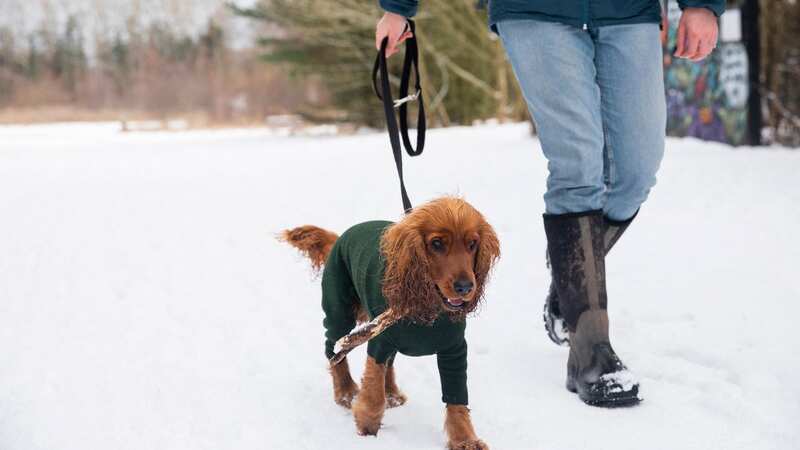Expert urges owners to walk dog inside house for 5 minutes before going outside

With snow and ice warnings sweeping across the country this week, with predicted temperatures below freezing, many dog owners are uncertain whether it’s safe to take their dogs on their usual walks, with one expert saying there are perils to look out for to protect your pooch if you do.
Pet insurance provider, Manypets resident vet, Dr. Kirsten Ronngren, has revealed her top tips on how to keep your dog safe in extreme weather, and the list may surprise you. From shoes to keep their paws and pads protected from snow, to ensuring your canine isn’t ingesting any rock salt or anti-freeze, there are many ways to ensure your walks are safe for your pups this season.
Paw patrol: When it’s snowing or icy out, it’s a good idea to get protection for their paws, so invest in a pair of canine-friendly shoes. This could come in the form of boots to prevent ice and snow from getting lodged between their toes or in their fur, or even just a balm for the pads. Many dogs may initially resist wearing boots, so take the time to let them get used to the sensation – try allowing them to wear the shoes indoors for short periods, rewarding them with treats and praise.
Read more: 'I took DNA test for a laugh - and accidentally uncovered my mum's devious past'
Road salt risks: If your dog isn’t wearing shoes, look out for rock salt or ice melt on the roads when it’s icy, as this can cause sores on your dog’s skin and paws and an upset stomach if it’s eaten. It can be tricky to prevent pets from coming into contact with rock salt, so make sure to wash their feet and legs after an icy walk. If you think they might have eaten some, it’s best to get in touch with your vet as even a small amount can cause serious problems.
 Gales, snow and rain to batter country today with 80mph wind gusts
Gales, snow and rain to batter country today with 80mph wind gusts
Antifreeze awareness: Pets most commonly come across this when it's leaked from a car radiator, or has been spilled while filling up the container under the bonnet of the car. Antifreeze containing ethylene glycol is extremely dangerous for cats and dogs, even if they’ve only given it a lick, and can cause potentially fatal kidney damage. If your pet has been near a spill, it’s important that you wash their paws with soap and water as soon as you can and the leak is cleared away.
Winter coat: Many dogs, especially breeds with thick fur, will be fine going about their usual walking routine in the winter, but smaller breeds, very young or old dogs, dogs with health conditions like arthritis, or breeds with shorter or fine fur like Greyhounds and Whippets, will feel the cold more and could be at higher risk of developing hypothermia and frostbite. Signs of hypothermia can include shivering, whimpering, acting lethargic, or seeming resistant to activity.
Visibility: With the cold comes the dark. It’s not possible for every dog owner to walk their dog earlier, so as the nights draw in it’s best to take precautions to keep you and your pet safe. Walk well-lit routes if you can and accessorise with something reflective for you and your pup, so it’s easy for drivers to see you.
Breed adjusted walks: Optimum walking length can depend on the breed of your dog, so it’s worth checking. For those of a higher risk breed, shorter is better. For healthy dogs with thick coats, or an added coat, a regular, brisk 30-minute walk or run around on the field would be fine.
Frosty paws precautions: The precise temperature that determines whether it’s too cold depends on the dog, as risk pets (which include young, old, thin and those with underlying issues) may find issues with temperatures that drop below 5-7 degrees. Larger dogs with thicker coats will be fine in these temperatures. When it hits below freezing, owners need to be diligent and aware that any dog walks in temperatures below freezing should be carefully considered.
Winter walk readiness: Preparation before a cold walk is key and you can let dogs stretch or get warmed up indoors before going outside, as this will help prevent muscle strain. Once you return home after a chilly walk, remove coats and boots soon after returning home to prevent dogs overheating indoors after being covered up.
Read more similar news:
Comments:
comments powered by Disqus

































